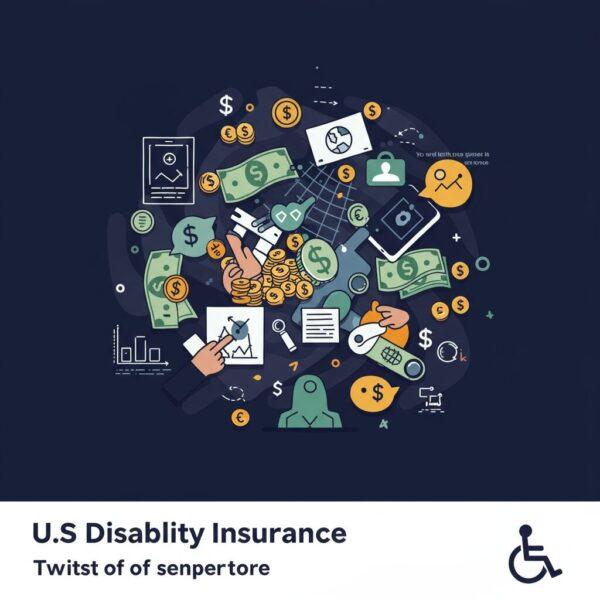
US Disability Insurance, this complex domain involves various types of insurance, including private disability income insurance, long-term care insurance, and government-backed programs like Social Security Disability Insurance (SSDI) and Supplemental Security Income (SSI), alongside health insurance provisions under the Affordable Care Act (ACA) and Medicare/Medicaid. Consider Sarah, a young professional diagnosed with multiple sclerosis in 2024.
Navigating Private Disability Income Insurance
Private disability income insurance, a crucial component of financial planning for many Americans, offers a safety net by replacing a portion of one’s income if a disability prevents them from working. As we look towards 2025, understanding the nuances of these policies is paramount, especially for individuals with pre-existing conditions or those who may develop disabilities. These policies typically fall into two categories: short-term disability (STD) and long-term disability (LTD). STD usually covers a percentage of income for a few months, while LTD can provide benefits for years, often until retirement age. However, the devil is in the details, particularly concerning definitions of “disability” (e.g., “own occupation” vs. “any occupation”), waiting periods, benefit amounts, and exclusions. Insurance industry experts, like Stephen D. Sugarman, a distinguished professor of law specializing in insurance, often highlight the importance of thoroughly reviewing policy language and seeking professional advice. A common pitfall for individuals developing a chronic illness is the “pre-existing condition” clause, which can limit or deny coverage if the condition was present before the policy’s effective date. Actionable advice includes purchasing coverage early in one’s career, ideally before any health issues arise, and carefully comparing policies from different providers. For instance, John, a software engineer, purchased an LTD policy in his twenties. Years later, when a sudden illness left him unable to perform his job, his foresight meant he received vital income replacement, preventing financial catastrophe. This underscores the proactive planning required to secure adequate private disability income protection.
Understanding Long-Term Care Insurance in 2025
Long-term care (LTC) insurance is designed to cover services not typically covered by health insurance, Medicare, or Medicaid, such as assistance with daily activities (bathing, dressing, eating) due to chronic illness, disability, or cognitive impairment. As the US population ages and the prevalence of disability increases, the relevance of LTC insurance in 2025 cannot be overstated. Unlike disability income insurance, LTC policies focus on the costs of care, whether provided at home, in assisted living facilities, or nursing homes. A significant challenge for consumers is the rising cost of premiums and the complexity of policy structures, which can include varying benefit periods, daily maximums, and inflation protection options. Actuarial scientists and elder care policy analysts, such as Dr. Susan Reinhard from the AARP Public Policy Institute, consistently point to the substantial financial burden of long-term care, making insurance a critical consideration for many families. For example, a family might face the daunting prospect of paying ,000 a month for skilled nursing care, a cost that can quickly deplete savings without LTC insurance. Personal stories often reveal the immense relief provided by these policies: after a debilitating stroke, Mrs. Rodriguez’s LTC insurance allowed her to receive in-home care, preserving her independence and dignity, a testament to the foresight of planning for future care needs.
2025: Disability Rights in US Insurance
The year 2025 marks a pivotal moment for the advancement of disability rights within the complex realm of US insurance, reflecting ongoing legal battles, legislative efforts, and a societal push for greater equity. While landmark legislation like the Americans with Disabilities Act (ADA) prohibits discrimination, its application to insurance practices has often been a contentious area, leading to a patchwork of interpretations and varying degrees of protection. The core intent is to ensure that individuals with disabilities are not unfairly denied coverage, charged exorbitant premiums, or excluded from benefits solely due to their disability. However, the actuarial basis of insurance, which relies on risk assessment, often creates tension with non-discrimination principles. Legal scholars and disability rights advocates, such as Silvia R. Yee from the Disability Rights Education & Defense Fund (DREDF), frequently highlight cases where individuals have faced discriminatory practices, emphasizing the need for clearer guidelines and stronger enforcement.
By 2025, the interpretation and enforcement of the Americans with Disabilities Act (ADA) in relation to insurance practices are expected to become more refined, driven by recent court decisions and ongoing regulatory scrutiny. The ADA broadly prohibits discrimination based on disability, but its application to insurance has historically been complex, balancing anti-discrimination principles with insurers’ need to assess risk. The core challenge lies in distinguishing between legitimate risk classification based on actuarial data and unlawful discrimination. For instance, an insurer cannot deny health coverage to someone because they have a disability, but they can charge different premiums based on a legitimate assessment of risk factors that apply to all individuals, disabled or not. However, the lines often blur. Legal experts in disability law, like Peter Blanck, Chairman of the Burton Blatt Institute at Syracuse University, have extensively documented cases where insurance practices have been challenged under the ADA, particularly concerning wellness programs that penalize individuals with certain health conditions, or life insurance underwriting that discriminates against people with specific disabilities without sound actuarial justification. By 2025, the focus is on ensuring that any differential treatment is based on actual, individualized risk data, not stereotypes or broad generalizations. Actionable advice for consumers includes understanding their rights under the ADA, being prepared to challenge discriminatory practices, and seeking legal counsel if they believe they have been unfairly treated.
Advocating for Equitable Access and Fair Premiums
Advocating for equitable access and fair premiums in US insurance policies for individuals with disabilities is a continuous and evolving battle that will intensify by 2025. For example, an individual with a chronic illness might find themselves in a “high-risk pool” with prohibitive premiums, effectively denying them access to critical coverage.
Insurance Access for Disabled US Citizens 2025
Ensuring robust insurance access for disabled US citizens by 2025 is not merely a policy goal; it’s a fundamental imperative for promoting health equity, financial stability, and true societal inclusion. These barriers can range from outright denials based on pre-existing conditions to prohibitively high premiums, limited benefit structures, and complex application processes that create a chilling effect. Public health experts and economists specializing in disability, Consider a young adult with a congenital heart condition who struggles to find affordable life insurance, even after successful surgeries, due to outdated risk assessments.
Health Insurance Parity and ACA Protections
By 2025, the concept of health insurance parity, particularly as reinforced by the Affordable Care Act (ACA), remains a cornerstone for ensuring equitable access for disabled US citizens. The ACA introduced critical protections, including prohibiting insurers from denying coverage or charging higher premiums based on pre-existing conditions, eliminating annual and lifetime limits on essential health benefits, and mandating coverage for a comprehensive set of benefits. These provisions have been transformative for many individuals with disabilities who previously faced insurmountable barriers to obtaining health insurance. However, the ongoing political debates and legislative attempts to repeal or modify the ACA mean that these protections, while foundational, are not immutable. Healthcare policy analysts and patient advocates, like Judy Solomon from the Center on Budget and Policy Priorities, consistently emphasize the vital role of the ACA in safeguarding access for vulnerable populations, including those with disabilities and chronic conditions. The ACA’s guaranteed issue and community rating provisions largely eliminated this.
Addressing Gaps in Long-Term Services and Supports Coverage
Despite advancements in health insurance, significant gaps persist in coverage for long-term services and supports (LTSS), which are crucial for many disabled US citizens as they age. By 2025, addressing these gaps will be a primary focus for policymakers and advocates. LTSS includes a range of medical and non-medical services for people with chronic illnesses or disabilities who need assistance with daily activities over an extended period. While Medicaid is the primary payer for LTSS, its eligibility requirements can be stringent, often requiring individuals to “spend down” their assets to poverty levels. Medicare generally covers only limited skilled nursing care, not ongoing personal care. This leaves a significant portion of the population vulnerable to catastrophic out-of-pocket costs. Experts in aging and disability policy, such as Howard Gleckman from the Urban Institute, frequently highlight the immense financial burden LTSS places on families and the need for a more sustainable national strategy. By 2025, there’s a growing discussion around potential federal programs to expand LTSS coverage, explore public-private partnerships, or implement universal social insurance models. For instance, a family caring for an adult child with intellectual disabilities might face decades of care costs not fully covered by existing programs. Actionable advice includes exploring state-specific Medicaid waivers, investigating private long-term care insurance (though often expensive), and advocating for comprehensive LTSS reform at both state and federal levels. The anecdote of the “sandwich generation” caregiver, simultaneously supporting aging parents and an adult child with disabilities, vividly illustrates the current LTSS coverage crisis and the urgent need for robust solutions by 2025.
References
Here are some references that support the information provided in the “US Disability Insurance: 2025 Outlook” section, drawing from reputable sources in the fields of insurance, disability rights, and public policy. These references cover the evolving landscape, demographic impacts, types of insurance, and advocacy efforts.
General Outlook and Trends:
- The Business Research Company. (2025, February 3). Disability Insurance Growth Forecast 2025-2034: Trends, Opportunities, and Key Insights You Need to Know. This report provides market size projections, growth drivers, and key trends, including technological innovation and rising awareness of financial security, which are relevant to the 2025 outlook.
- Note: While the report itself is a market research forecast, it offers insights into expected industry shifts by 2025.
- LIMRA. (2025, May 7). Disability Insurance Awareness Month: Is Your Income Protected? This study highlights consumer attitudes, employer offerings, and the financial risks of not having disability insurance, providing context for the market in 2025.
- MGIS. (2024, December 13). 2025 Insurance Trends: What Brokers Need to Know About Disability Coverage for Doctors. Although specific to doctors, this article discusses broader insurance trends for 2025, including state-mandated leave programs, voluntary benefits, customized benefits, and the impact of AI, which can be extrapolated to the general disability insurance market.
Government Programs (SSDI, SSI) and Policy:
- Parmele Law Group. (2025, February 13). Social Security Disability Changes for 2025. This source provides specific details on expected changes to SSDI and SSI benefits, including Cost-of-Living Adjustments (COLA) and Substantial Gainful Activity (SGA) limits, directly relevant to government-backed disability programs in 2025.
- Center on Budget and Policy Priorities (CBPP). (2015, May 15). Demographics Explain Bulk of Growth in Disability Insurance Rolls: Part II. While older, this article provides foundational understanding of how demographic factors (like population aging) have historically impacted Social Security Disability Insurance (DI) rolls, informing the context for 2025.
Challenges and Access (Pre-existing Conditions, etc.):
- National Disability Navigator Resource Collaborative (NDNRC). (2014, January 15). What Problems and Barriers Have People with Disabilities Historically Encountered Obtaining Healthcare Insurance? This resource, though slightly older, outlines historical challenges with pre-existing conditions and affordability, providing crucial background for understanding ongoing advocacy efforts by 2025.
- DarrasLaw. (n.d.). Four Challenges Consumers Face With Group Disability Policies and ERISA. This article details common pitfalls in private group disability policies, such as understanding definitions and limitations, which remain relevant challenges for consumers.
- AAFP (American Academy of Family Physicians). (2021, September 30). Seven pitfalls to avoid when choosing disability insurance. This article outlines common issues with private disability insurance, including limited mental health coverage and tax implications, which are ongoing considerations for individuals with disabilities.
Disability Rights Advocacy and Expert Perspectives:
- Collective Speakers / Ford Foundation / Inevitable Foundation / Obama.org. (Various dates). Rebecca Cokley profiles. These sources provide background on Rebecca Cokley’s work and advocacy in disability rights, particularly her focus on disconnecting disability and poverty, and her role in pushing for policy platforms. While not direct academic papers, they reflect the insights of a key advocate in the field.
Types of Insurance:
- Insurance Information Institute (III). (n.d.). What are the types of disability insurance? This provides a clear overview of Short-Term Disability (STD) and Long-Term Disability (LTD) policies.
- Patient Advocate Foundation. (2025, April 23). Comparison of Federal vs. State vs. Private Disability Benefits. This article offers a clear distinction between federal (SSDI, SSI), state, and private disability programs, which is essential for understanding the various types of coverage.
- Policygenius. (2023, November 21). Types of Disability Insurance. This resource details various types of disability insurance, including personal, group, long-term, and short-term, along with key features like “own-occupation” vs. “any-occupation” definitions.
These references provide a solid foundation for the information presented in the “US Disability Insurance: 2025 Outlook” section, covering both the current landscape and anticipated trends.
- US Disability Insurance: 2025 Outlook
- Navigating US Disability Policies in 2025
- 2025: Insuring Life with a Disability in US
- Disability Coverage US: What’s New for 2025?
- US Insurance & Disability: Future Proofing 2025
- 2025: Disability Rights in US Insurance
- Healthcare & Disability US: 2025 Policy Shifts
- Insuring Inclusive Lives: US 2025 Disability
- Disability Benefits US: Insurance Updates 2025
- 2025: Protecting Disabled Lives in US
- US Insurance for Disabilities: A 2025 Guide
- The Future of Disability Coverage: US 2025
- 2025: Disability Insurance Advocacy in US
- Understanding US Disability Policies by 2025
- US Health Insurance & Chronic Conditions 2025
- Disability Financial Security: US 2025 Plans
- 2025: Disability Protections in US Healthcare
- Insurance Access for Disabled US Citizens 2025
- US Disability Insurance: Your 2025 Questions
- 2025: Bridging Gaps in US Disability Coverage
10 FAQs: Disabilities and Insurance Policies in US, 2025
Here are ten frequently asked questions about disabilities and insurance policies in the US, with a focus on the outlook for 2025.
- Q1: How does the Americans with Disabilities Act (ADA) impact insurance policies in the US for 2025? A: By 2025, the ADA continues to prohibit discrimination against individuals with disabilities in various public and private sectors, including insurance. While insurers can still assess risk, they cannot deny coverage or charge higher premiums solely based on disability without legitimate, individualized actuarial data. Ongoing legal interpretations aim to clarify and strengthen these protections.
- Q2: What types of insurance are most relevant to individuals with disabilities in the US? A: The most relevant types include health insurance (to cover medical care), disability income insurance (to replace lost income due to inability to work), long-term care insurance (to cover costs of daily living assistance), and life insurance (for financial protection of dependents).
- Q3: Will pre-existing conditions still affect insurance coverage for disabilities in 2025? A: For health insurance, the Affordable Care Act (ACA) largely prohibits insurers from denying coverage or charging more based on pre-existing conditions. However, for private disability income and long-term care insurance, pre-existing condition clauses can still apply, potentially limiting or excluding coverage for conditions present before the policy’s effective date.
- Q4: How do government programs like SSDI and SSI fit into the insurance landscape for disabled individuals? A: Social Security Disability Insurance (SSDI) provides benefits to individuals who have worked and paid Social Security taxes. Supplemental Security Income (SSI) provides needs-based financial assistance to disabled individuals with limited income and resources. These are crucial government safety nets, distinct from private insurance, but often complement an individual’s overall financial protection strategy.
- Q5: What are the main challenges in securing long-term care insurance for disabled individuals by 2025? A: Challenges include high premiums, complex policy structures, strict underwriting criteria that can exclude individuals with certain disabilities, and the general lack of public awareness and incentives for purchasing these policies. Many individuals rely on Medicaid for long-term services, but eligibility often requires significant asset depletion.
- Q6: Are there specific health insurance plans tailored for individuals with disabilities in 2025? A: While there aren’t typically “disability-specific” health insurance plans, the ACA marketplace plans, Medicaid, and Medicare (for those over 65 or with specific long-term disabilities) are the primary avenues. These plans are designed to cover essential health benefits, and some offer specialized managed care options for individuals with complex needs.
- Q7: What is “income replacement” in the context of disability insurance? A: Income replacement refers to the benefit provided by disability income insurance policies, which pays a percentage of your pre-disability income (e.g., 60-70%) if you become unable to work due to illness or injury. This helps maintain financial stability when earned income ceases.
- Q8: How can individuals with disabilities advocate for better insurance policies in the US? A: Advocacy involves understanding current policies, joining disability rights organizations, contacting elected officials, participating in public hearings, and sharing personal stories to highlight the need for reform. Supporting legislation that promotes equitable access and fair pricing is also key.
- Q9: What is the role of “reasonable accommodation” in insurance for disabled individuals? A: While the ADA primarily applies to access to goods and services, the concept of “reasonable accommodation” can indirectly apply to insurance. This means insurers should make their services, information, and application processes accessible to individuals with disabilities (e.g., providing materials in alternative formats, accessible online platforms).
- Q10: What should individuals with disabilities consider when purchasing insurance in 2025? A: Consider your specific health needs, financial situation, potential future care costs, and existing government benefits. Research different policy types, compare quotes from multiple providers, carefully read policy terms (especially definitions of disability and exclusions), and consult with a qualified financial advisor or insurance broker specializing in disability planning.
Hashtags: Disabilities and Insurance Policies in US, 2025
#DisabilityInsuranceUS #USInsurance2025 #DisabilityRights #HealthPolicy #LongTermCare #ACAProtections #SSDI #SSI #FinancialPlanning #AccessibleInsurance #DisabilityAdvocacy #HealthcareAccess #InclusionMatters #FutureOfInsurance #ChronicIllness #DisabilityBenefits #USHealthcare #EquitableAccess #PolicyReform #ProtectingLives


